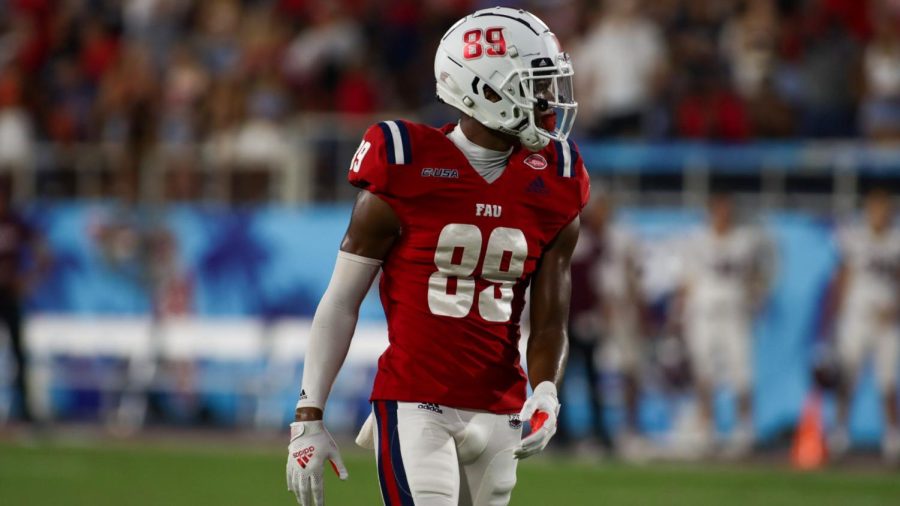NFL Draft Analysis: Wide receiver Brandon Robinson could be the missing piece to an NFL offense
Robinson’s size and hands could be a viable option for teams looking to draft a wide receiver late.
Photo of #89 wide receiver Brandon Robinson setting up for a play.
April 24, 2022
With the NFL Draft set to begin on Thursday, April 28, several former Owls are hoping to have their dreams of playing in the pros fulfilled by hearing their name called.
With his announcement in December, wide receiver Brandon Robinson became one of four FAU receivers looking to earn a spot on an NFL roster.
Robinson began his career at Warner University in Lake Wales, Fla., but transferred to FAU in 2017 after a single season with the Royals.
Though he was a member of the 2017 C-USA Championship Team, Robinson did not see the field until the 2019 season when he finished with seven receptions for 122 yards and a touchdown.
Robinson gradually improved his stats every year, finishing the 2020 season with 12 receptions for 145 yards and three touchdowns. He saved his best season for last, however, racking up 37 receptions for 481 yards and four touchdowns in 2021.
Here are the strengths and weaknesses of Robinson and what he can bring to an NFL roster.
Strengths
Robinson’s biggest upside is that he uses his enormous frame well.
At FAU’s Pro Day, he measured in at 6-foot-2.5-inches and 202 pounds, which puts him in the upper percentiles of draft-eligible receivers.
Robinson frequently puts that size to use by boxing out smaller defensive backs to make contested catches, which made him a consistent target in third down and short-yardage situations.
He was also an asset in the run game because his size made him a good blocking receiver, which all pro scouts and coaches will appreciate.
Weaknesses
Robinson’s downside is that he lacks pro level speed.
He really struggled to gain separation from cornerbacks, which he sometimes made up for with his ability to make contested catches.
However, the bigger and faster defensive backs he will face in the NFL will only give him more problems than he faced in college.
The 4.85 seconds in the 40-yard dash he ran at Pro Day will only draw more questions on his ability to gain separation.
Best Fit
Robinson’s best fit would be with a team looking to add an offensive weapon in the form of an outside receiver, also known as an “X” receiver.
This year’s draft class is loaded with talent at the wide receiver position, so if a team were to select Robinson, it will likely be one that has bigger needs to fill in the early rounds and are looking to grab a receiver late.
The Jacksonville Jaguars seem like a good fit. This offseason, they made surrounding their second-year quarterback Trevor Lawrence with talent their top priority with the signings of wide receivers Christian Kirk and Zay Jones. To many, however, their receiver group still feels incomplete.
The Jaguars are expected to use most of their early draft picks on defense and offensive line, so Robinson may be a good option if they opt to add a receiver in the final rounds.
The Atlanta Falcons could also be a good landing spot. They’re expected to draft a quarterback in the first round after trading Matt Ryan to the Indianapolis Colts, and with their current set of available receivers, playing in Atlanta would be a disaster for any rookie quarterback.
With the surplus of receiver talent in this draft class, they will likely get a bigger name receiver in the second or third round, but could still be looking to get weapons for a young quarterback in the late rounds where Robinson could be a viable option.
Cameron Priester is a staff writer for the University Press. For information regarding this or other stories, email [email protected] or tweet him @PriesterCameron.






